Do I like South Korean food?
I am sorry to say that it is a resounding no for me. I don’t like hot, chilli-infested food and I don’t like fermented things and I don’t like bones and food-faff things.
However, I did enjoy some dishes. I loved the novelty of food different to my usual diet, I appreciated that I lost half a stone in the two weeks I was there and I very much enjoyed the freshness of most food we ate; the South Koreans really make the most of what is in season (in the winter-spring time we were there, a lot of what was available was root-based).
What food did I like?
Bulgogi – marinated meat with flavours of soy sauce, garlic, pepper, ginger, onions and sometimes mushroom. It tastes lovely wrapped in lettuce leaves.
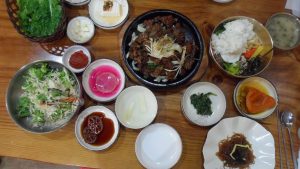
Galbi – marinated grilled meat that you usually cook for yourself on a grill in the middle of the table. It is fun and delicious.
Bibimbap – warm rice topped with all or some of the following: vegetables, meat, raw egg (good when it’s mixed in and lightly cooked with the warm rice) and chilli paste. I didn’t enjoy all bibimbap dishes we tried but some were good. It wasn’t a favourite dish though.
Jeon – thick pancakes: batter with meat, fish and/or vegetables. I really like these pancakes and you often see them cooked and ready to re-fry around market stalls. The vegetable ones are really nice, as are prawn ones. Actually, I just really like them! No chilli paste in any of the ones I had; what a relief.
With every meal, you get between about seven and 20 side dishes. These for me were a big challenge as I largely disliked them. They are great for experimenting with eating things you’ve never eaten before and if you like fermented and/or challengingly hot/chilli things, you’re more likely to enjoy them than me. It really is a case of, “Is this meat, fish, vegetable or other?” for a lot of things.
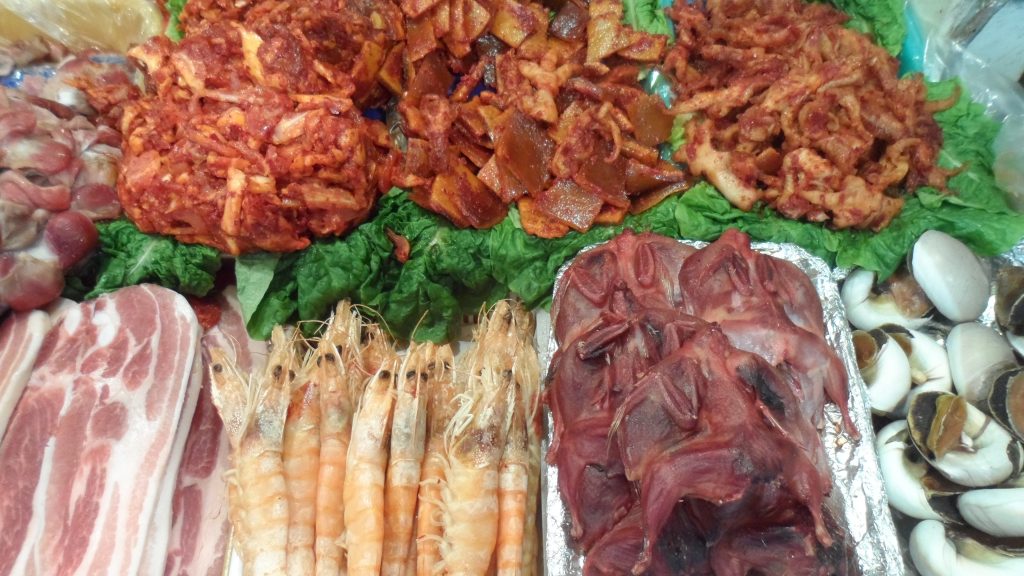
How easy is it to find non-Korean food
We only once ate out in a non-Korean restaurant (our choice), and that was an Italian restaurant in Jeonju, which was very nice but there was more chilli than I’d expect with Italian dishes (so, yes, it was Korean Italian food – and the staff ate Korean food in their break time, which I thought was very amusing!).
There are various familiar chains, such as McDonald’s, and there are quite a lot of European-style bakery type places. There is a chain called Paris Baguette that you can find pretty much everywhere. At first they were a novelty, but after a while the mystery of what you were buying (no English labels) was quite distressing, especially as some savoury things ended up being sweet. You will be very disappointed if you go into a Paris Baguette expecting French bread and pastries; there is a very definite South Korean emphasis.
In Seoul, there is of course a lot more variety, and it’s not impossible to find non-Korean restaurants but there aren’t as many as you might expect. But if you do not like being out of your food comfort zone, going outside Seoul probably isn’t advisable for you.
What are drinks like in South Korea?
There are a lot of coffee shops selling good quality but expensive coffee. You can also get a decent tea.
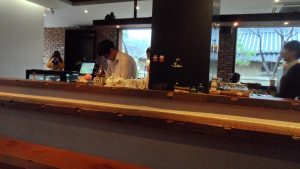
However, “milk tea” is a glorified warm milk shake with a slight tea flavour. “Black tea” you can order with milk on the side.
Always specify if you want “hot” or “cold”, eg, believe it or not, “one HOT cappuccino, please” is required if you do indeed want a hot coffee.
There are a lot of varieties of coffee so it might be fun to experiment a bit if you are not a coffee purist like me!
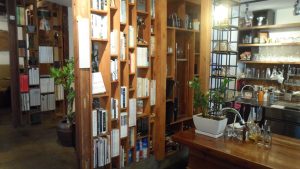
Soju, a South Korean … well, it’s like rocket fuel and you can taste the alcohol. South Korean men in particular seem to consume a good few bottles of the stuff with their meals.
South Korean beers all seemed nice.
There are a lot of exciting-looking soft drinks available, including energy drinks with ginseng.
How much does food and drink cost?
* All GBP rates at my exchange rate in April 2013 of £1=1,560 won
It varies hugely. The VERY touristy old/hanok village of Jeonju was by far the most expensive area we ate or drank in, for example a hot chocolate and a coffee cost 14,000 won (£8.98) and two teas at Blue Pekoe cost 12,000 won (£7.70).
Did we get ripped off?
We were really upset and angry that we got ripped off at a street food “restaurant” around Namdamun Market (in photo below) and it really tainted our stay in Seoul. That was our only payment/food issue.

We weren’t overcharged in terms of the menu. Where it went horribly wrong was that we pointed to all the things we wanted (pancakes, octopus, noodles, mushrooms and chicken skewers). We got one pancake each but had only asked for one. We had thought we’d asked for the octopus, noodles and mushrooms to be cooked together (she even piled the three things on top of each other to confirm what we’d wanted) but we got the octopus and noodles together, a big plate each, and we got another plate each full of mushrooms and vegetables. As for the chicken skewers, we’d pointed to the chicken chunk ones and asked for one each. We got a plate with sauce (hadn’t expected that and didn’t want it as the sauce was the same with every dish) and the nice chicken chunks but also the hearts(I think), which we hadn’t wanted or ordered. So we paid for all those things. Instead of paying for one portion of pancake, two small chicken skewers and a noodle, octopus and mushroom dish; we paid for two pancakes, four chicken skewers in sauce, two octopus and noodles in sauce, two mushrooms dishes in sauce, so ten separate dishes instead of the four dishes (two of which were just a small skewer of grilled chicken each). It came to 93,000 won (£59.62).
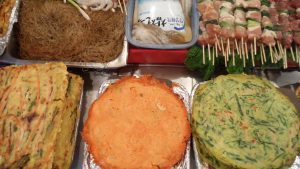
My advice there would be to not buy anything without seeing the menu or being given prices (there was a menu that we checked afterwards and the prices were the same as other stalls and were what we’d been charged on our bill). Also, indicate with your finger how many you want (I think we made that clear but, with hindsight, we should have questioned the size of each portion and that we were getting two plates rather than the one we expected to share). Maybe even ask how much it will come to before you sit down to eat.
The food was good and we’d enjoyed the street eating thing until it came to paying. We weren’t the only people who had issues though as a table who paid ahead of us also had an issue, but we didn’t know what it was, though I suspect it was the same thing. It all really, really upset us both; it’s horrible feeling ripped off. We had never and did never spend anywhere near that much for a meal again and we went to some very nice restaurants and had some far superior food to that.
What is street food like?
There are so many stalls around South Korean towns, I think it’d be a shame not to eat from a few. Despite being ripped off once, as detailed above, all other experiences were positive.
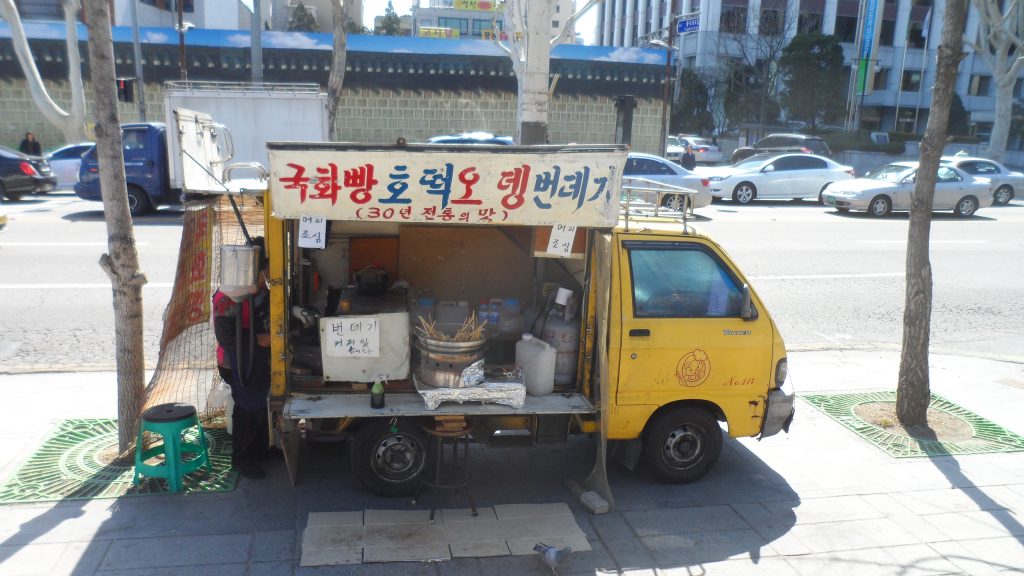
Within the larger markets in Seoul and Busan (and probably other places as well), certain kinds of food are often clustered together. For example, we found ourselves in an intestines restaurant in (unbeknownst to us until we’d taken our seats) an area full of intestine stalls/restaurants in Seoul’s Gwangjang Market. There was no English menu and no staff spoke English so a customer interpreted a bit for us. We asked what we could have and it transpired that, while you could have chicken, beef, pork, etc, you could only get intestines. Having consumed intestines in Japan, I couldn’t face a dinner I didn’t want to eat so we left and ended up eating extraordinarily spicy noodles elsewhere. I really, really can’t stomach (*snigger) intestines.
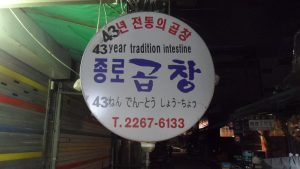
If something looks good or there is a big queue, give it a go. We did that on two particular occasions for sweet treats and both were really delicious! One was a van selling hot (as in not cold; there was no chilli!) red bean paste (adzuki bean) pancakey buns (a van just outside Changdeokgung Palace) and the other was around Anguk-dong where we joined a very long queue and ended up with honey filled doughy fried things that were hot and delicious.
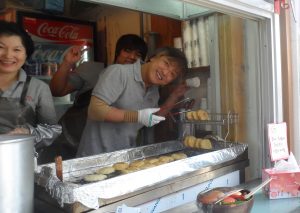
What can you expect to find on a Korean menu?
Most places have English menus and if not, there will usually be someone found in the restaurant (whether staff or another customer) who can speak English and Korean to help.

I have been to a few Korean restaurants in the UK but the food in South Korea, unsurprisingly, is quite a bit different. If it says it has chillies in it, there will be about 30 more chillies in it than you’d expect.
You will usually find at least one of the dishes I listed above as being ones I liked, which are also probably the most popular/common ones for the Western palate.
A lot of restaurants will specialise in just one type of dish or meat or style of cooking and this can be either really good or really bad, obviously. We did end up walking out of a few restaurants when we found out what it was they specialised in (ie something we didn’t like, intestines, or something we hadn’t fancied eating , eg stews when we wanted bibimbap).
Dried fish is popular, as is seaweed.
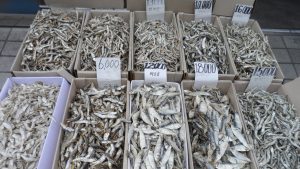
You will always get kimchi (fermented cabbage with chilli – that’s how I think of it now. I thought I liked kimchi until I had it every day) and other side dishes. To me, these are largely foul but you get them whether you want them or not.
What are Korean breakfasts like:
If you don’t like the side dishes, the odds are you won’t enjoy breakfast much more. However, omelet rolls are nice, soup is nice (similar to miso soup) and you get rice.
We had breakfast in our first hanok guest house in Seoul in the owner’s kitchen. We thought it was expensive at 10,000 won each (£6.41). We were served baby anchovies (c 2cm long almost transparent lines with black dots that would have become eyes) with almonds, burdock with lotus root (I liked this), a spicy root, kimchi, red bean rice, soup and cold omelet wraps. It was all fresh and organic.
What are portion sizes like:
Much bigger than I expected. We often ordered a dish each and wished we’d just ordered one thing to share. I suggest, unless you’re ravenous, that you order one dish then order another if that doesn’t look like much.
You will also get the side dishes. If you like them, they can fill you up a bit.
Some examples of prices:
Set meals – we paid between 9,000 won (£5.77) and 12,000 won (£7.70) each for feasts with up to 20 dishes. Very good value.
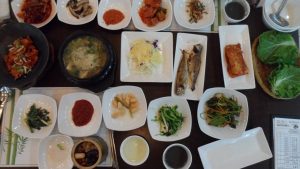
Set meal for lunch in an Italian restaurant (in Jeonju where everything is expensive but the set meal was a lot cheaper than anything else as it came with bread, a large, delicious fruit and foliage salad, fresh seafood spaghetti and dessert which it transpired was orange juice or coffee) – 16,000 won (£10.26).
Fast food noodle restaurant – dumplings (4,000 won – £2.56), chicken and udon (6,500 won – £4.17)
Local speciality seafood soup restaurant (Gunsan) – a massive clam, cockle and mussel noodle soup (6,000 won – £3.87)
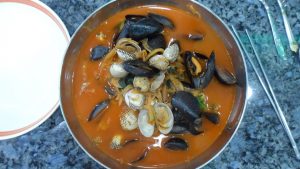
Trendy galbi restaurant (Suwon) – an excellent and big meal of very good quality meat, mushrooms and vegetables that we grilled ourselves, one small soju to share and a beer each (27,000 won each – £17.31 each)
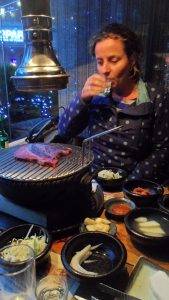
A non-trendy galbi restaurant/canteen (Busan) – decent, substantial meal of meat and vegetables grilled in front of us, just drank free water – 11,500 won each (£7.37)
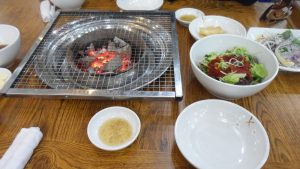
Bottle of beer in a restaurant – 4,000 won – £2.56
Pizza and a soft drink in a trendy wood fired pizza restaurant/bar (Daegu) – 10,250 won (£6.57)
Bibimbap and a pancake (shared) (Hahoe Folk Village) – 14,000 won for the two dishes, which we shared (£8.97 for both of us)
Feast of raw fish and all things fish, complete with loads of side dishes (photo below) and fish soup (which we asked not to have at the end as we were full from the huge amount of raw fish and side dishes) and a beer (Busan fish market) – 22,000 won each (£14.10)
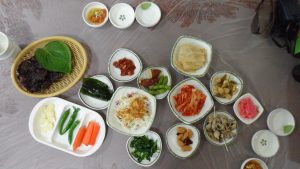
Cappuccino – c4,000 won (£2.56), except in Jeonju where they were at least double the price.
Restaurant etiquette
Spoons and chopsticks are usually stored in a box on your table or in a drawer under the table top. Chopsticks are metal and flatter than Japanese ones, for example.
Spoons are for soup and rice, chopsticks for everything else.
There is often a bell or buzzer at your table, which I love, as you never have to wait long for a member of staff to serve or help you.
You generally pay your bill at the till rather than at the table. I also love this system as it means you don’t have to sit around waiting for someone to take your money when you’re ready to go.
You don’t generally tip, though apparently you should at high end hotel restaurants.
You should always pour drinks for other people and use both hands when pouring or receiving drink.
Don’t leave your spoon or chopsticks sticking up in food, it’s rude.
